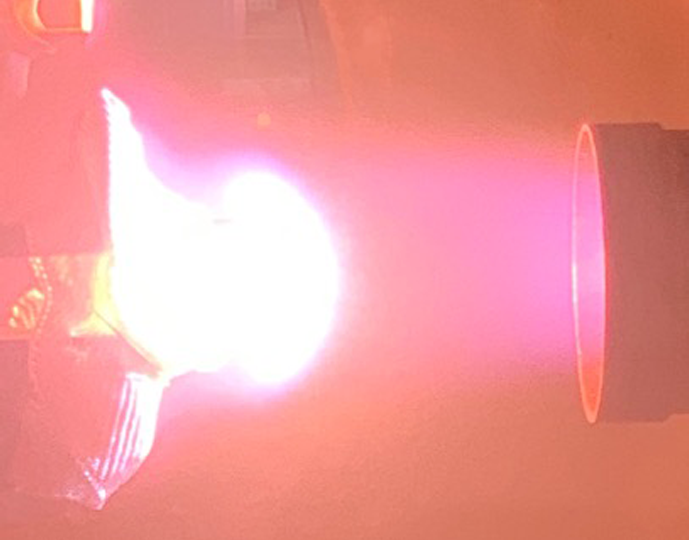As far as space shuttles and high-speed vehicles are concerned, wide usage has been done in carbon fiber-reinforced ultra-high-temperature ceramic (UHTC) matrix composites. But these composites experience an absence of oxidation resistance.
 Researchers from the Tokyo University of Science evaluated the utility of C/UHTCMC at temperatures above 2000 degrees Celcius using arc-wind tunnel testing (pictured above). These results show degradation of the composite at high temperatures, which is an important result for the manufacture of advanced space shuttle orbiters.
Researchers from the Tokyo University of Science evaluated the utility of C/UHTCMC at temperatures above 2000 degrees Celcius using arc-wind tunnel testing (pictured above). These results show degradation of the composite at high temperatures, which is an important result for the manufacture of advanced space shuttle orbiters.
In recent times, scientists from Japan tested the heat resistance of such composites at very high temperatures, thereby offering knowledge of the alterations required to avoid UHTC degradation. Their study findings could exhibit huge impacts on the manufacture of space shuttle orbiters.
Carbon fiber-reinforced carbon (C/C) is a composite material made of carbon fiber reinforced in a matrix of graphite or glassy carbon. It is ideally known as the best material utilized in hypersonic vehicles and space shuttle orbiters, which cruise at speeds surpassing Mach 5.
Since the 1970s, it has also been utilized in the brake system in Formula One racing cars. Although C/C exhibits outstanding mechanical properties at high temperatures and inert atmospheres, it lacks oxidation resistance in such conditions, thereby restricting its extensive use.
Scientists have discovered that ultra-high-temperature ceramics (UHTCs), including transition metal carbides and diborides, display good oxidation resistance. In earlier studies, zirconium-titanium (Zr-Ti) alloy infiltration has displayed encouraging outcomes for enhancing the heat resistance of carbon fiber-reinforced UHTC matrix composites (C/UHTCMCs). But, their use at high temperatures (>2000 ℃) is yet to be identified.
Set against this backdrop, a research team from Japan has assessed the possible utility of Zr-Ti alloy-infiltrated C/UHTCMCs at temperatures above 2000 ℃.
Their study, headed by Junior Associate Professor Ryo Inoue from Tokyo University of Science (TUS), was reported in the Journal of Materials Science and made available online on October 27th, 2022.
The research team comprised Mr. Noriatsu Koide and Assistant Professor Yutaro Arai from TUS, Professor Makoto Hasegawa from Yokohama National University, and Dr. Toshiyuki Nishimura from the National Institute for Materials Science.
Speaking of the motive behind their study,
The research is an extension of the research and development of ceramics and ceramics-based composite materials. In recent years, we have received inquiries from several manufacturers of heavy industries regarding materials that can be used at temperatures above 2000 °C. We have also started to work with these manufacturers to develop new materials.
Ryo Inoue, Junior Associate Professor, Tokyo University of Science
The C/UHTCMC was manufactured utilizing melt infiltration, the most affordable method to fabricate such materials. To study the material’s applicability, three kinds of C/UHTCMCs were fabricated with three various alloy compositions.
The three alloy compositions utilized altered the atomic ratios of Zr: Ti. For the heat resistance to be characterized, the team utilized a technique known as arc-wind tunnel testing. This technique reveals the material to extremely high enthalpy airflow within a tunnel. This is similar to conditions that spacecraft tend to experience while re-entering the air.
The research group discovered that the amount of Zr present in the alloy exhibited a powerful effect on the degradation of the composite for all temperatures. This results from the thermodynamic choice for the oxidation of Zr-rich carbides than the Ti-rich carbides.
Furthermore, the Zr and Ti oxides developed on the composite surface avoided additional oxidation, and the oxide composition relied on the composition of the infiltrated alloys. Thermodynamic analysis disclosed that the oxides developed on the composite surface were composed of ZrO2, ZrTiO4, and TiO2 solid solutions.
At temperatures exceeding 2000 ℃, the samples’ thickness and weight are increased with the Zr content of the composites following the arc-wind tunnel tests. Also, the team noted that the melting point of the surface oxides went high as the Zr content increased.
For temperatures above 2600 ℃, the only oxides developed were liquid-phase, and it needs a thermodynamic design of the matrix composition to avoid the recession of UHTC composites.
We have successfully studied the degradation of C/UHTCMC at temperatures above 2000 ℃ using thermodynamic analysis. We have also shown that the matrix design needs modification to prevent the degradation of the composites. Our research has the potential to contribute to the realization of ultra-high-speed passenger aircraft, re-entry vehicle, and other hypersonic vehicles.
Ryo Inoue, Junior Associate Professor, Tokyo University of Science
Such outcomes could exhibit essential impacts on the production of high-speed vehicles and sophisticated space shuttle orbiters.
Journal Reference:
Koide, N., et al. (2022) Degradation of carbon fiber-reinforced ultra-high-temperature ceramic matrix composites at extremely high temperature using arc-wind tunnel tests. Journal of Materials Science. doi.org/10.1007/s10853-022-07861-x.